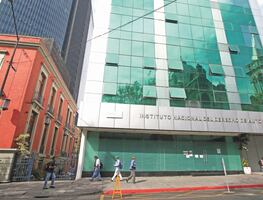Más Información

VIDEO Aplazan audiencia de Ximena Pichel "Lady Racista" por discriminación; integrantes de colectivo la agreden al salir lanzándole refrescos

Caso Epstein: Ghislaine Maxwell proporcionó al Departamento de Justicia información sobre 100 personas vinculadas al magnate

Caen dos probables responsables de asesinato de la maestra jubilada Irma Hernández; pertenecerían a la Mafia Veracruzana
Amid the dispersion of “La Unión Tepito,” the Jalisco Nueva Generación Cartel ( CJNG ), along with drug trafficking organizations from Sinaloa and Michoacán, has become one of the main drug suppliers for drug dealers in Mexico City.
According to federal reports, “The Jalisco New Generation Cartel is currently distributing drugs to local groups. La Unión Tepito is too disperse, and it has allowed [the CJNG] to operate in neighborhoods located in the boroughs it controls.”
The CJNG currently supplies drugs to drug dealers in the following boroughs: Gustavo A. Madero, Cuauhtémoc, Tlalpan, Xochimilco, Milpa Alta, Tláhuac, Benito Juárez, Miguel Hidalgo, and Cuajimalpa.
One of the official reports EL UNIVERSAL had access to indicates the CJNG, led by “El Mencho ,” has attempted to control illicit activities in the capital through special operations, and drug distribution. Nevertheless, the report explains the bloody cartel hasn’t been able to become the only dominating cartel in Mexico City because federal and local authorities have arrested its operators and allies.
Recommended: The CJNG devises plan to control the center of the country
“In Mexico City [the CJNG] doesn’t have an antagonistic group, it is not like in other states where the CJNG has to fight to enter, here authorities have prevented its arrival,” the report indicates.
Through “La Anti-Unión Tepito,” the Jalisco New Generation Cartel entered the city to sell and distribute drugs, as well as kidnap and extort people. However, authorities arrested cartel leaders such as Jorge Flores Conchas, aka “El Tortas,” and Jorge Miguel Rodríguez Muñoz, aka “El Cabezas.”
“El Tortas ,” who was sentenced to eight years behind bars, received the support of the Jalisco New Generation Cartel. The CJNG provided him with money, weapons, drugs, vehicles, gunmen, and training in a bid to expand its operations in Mexico City and Toluca, Ecatepec, Tlalnepantla, Naucalpan, Atizapán de Zaragoza, and Cuautitlán Izcalli, in the State of Mexico.
According to federal authorities, the CJNG reinforced its smaller groups in the city to control rival criminal organizations and gathered information to locate and kill the leaders of “La Unión Tepito .”
Nevertheless, Mexico City authorities delivered a major blow to the Jalisco cartel when they arrested Carlos Fernando Huerta, aka “El Viejón,” the CJNG leader in the capital. Moreover, authorities said he was the cartel leader who organized the murder of two Israeli criminals in Mexico City in 2019.
Furthermore, local authorities dismantled a small group deployed by the CJNG in April 2020. It was led by María del Carmen Albarrán García, aka “Doña Ceci,” who sold drugs in the Gustavo A. Madero, Venustiano Carranza, and Azcapotzalco boroughs.
Recommended: The CJNG aims to control Mexico City
Earlier this week EL UNIVERSAL revealed the CJNG entered the center of the country three years ago, by deploying small groups or creating alliances with local cartels in Guerrero, Morelos, State of Mexico, Mexico City, Puebla, Hidalgo, and Querétaro.
Nemesio Oseguera Cervantes, better known as “El Mencho,” created the infamous cartel in 2010. Five years later, the cartel started operating outside Jalisco in a bid to expand throughout the country, and control drug trafficking, kidnappings, and extortion, among other crimes.
According to federal reports, the CJNG recruits young men from different states and then sends them to Puerto Vallarta, Jalisco. There, former Colombian soldiers and ex-FARC members train them to murder and take over areas controlled by rival cartels.
The CJNG’s expansion in the center of the country facilitated its arrival in Mexico City. The violent cartel sent its trained gunmen to the capital in small groups, where they coordinate many important operations for the cartel.
In his attempt to control Mexico City , “El Mencho” deployed between five and six criminal groups to the city in the last 12 months. These groups allied with “Fuerza Anti-Unión Tepito” to control boroughs like Gustavo A. Madero, Cuauhtémoc, Tlalpan, Xochimilco, Milpa Alta, Tláhuac, Benito Juárez, Miguel Hidalgo, and Cuajimalpa.
A federal official said the CJNG does not have a rival in Mexico City, “it is not like in other states where the Jalisco cartel has to fight, authorities have prevented it from entering the city.”
Cartel Jalisco Nueva Generación
The CJNG was originally known as the Zeta Killers and first appeared in 2011, with the display of the bodies of 35 alleged members of Los Zetas. Although the criminal organization is based in Jalisco, it also operates in Colima, Michoacán, the state of Mexico, Guerrero, and Guanajuato.
The Cártel Jalisco Nueva Generación allegedly served as an armed group for the Sinaloa Cartel until 2013.
In 2015, the Mexican government declared CJNG one of the most dangerous cartels in the country. In October 2016, the U.S. Department of the Treasury described the group as one of the world’s “most prolific and violent drug trafficking organizations.”
According to some analysts, the CJNG has operations throughout the Americas, Asia, and Europe.
Moreover, the brutal Mexican cartel has been linked to several mass graves in southwestern Mexico and shot down an army helicopter in 2015.
The Jalisco New Generation Cartel distributes drugs in Los Angeles, New York, Chicago, and Atlanta. Furthermore, this drug trafficking organization is “one of the most powerful and fastest-growing cartels in Mexico and the United States” as it has a presence in at least 24 of 32 Mexican states.
This drug cartel is characterized by its rapid expansion and its willingness to “engage in violent confrontations with Mexican Government security forces and rival cartels.”
gm











